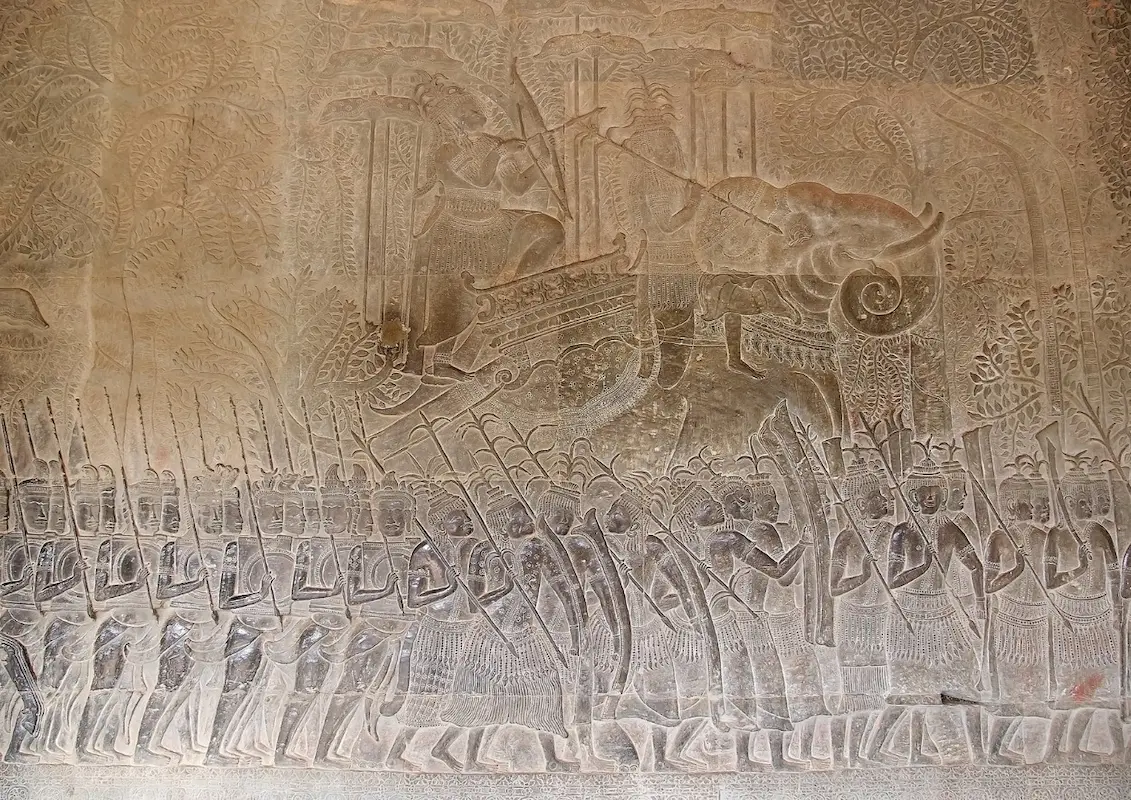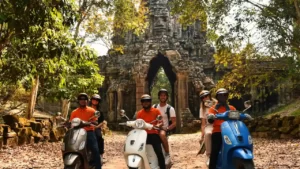Angkor Wat was constructed in the early 12th century during the reign of King Suryavarman II. The temple complex is a prime example of classical Khmer architecture. Originally serving as a Hindu temple, Angkor Wat switched from Hinduism to Buddhism twice due to the beliefs of different kings. The first transition to Buddhism occurred in the late 12th century under King Jayavarman VII, who converted it to Mahayana Buddhism. Then there was a brief return to Hinduism: after Jayavarman VII’s death, some Hindu practices were restored. By the 14th century, Angkor Wat fully embraced Theravada Buddhism, which remains the dominant religion. This shift in religious focus is reflected in the additional Buddhist sculptures and reliefs integrated into the site over time.
Key Bas-Relief Scenes:
- Battle of Kurukshetra: This scene, located in the south wing of the west gallery, illustrates the epic battle from the Mahabharata, depicting the fierce clash between the Kauravas and Pandavas.
- Churning of the Sea of Milk: One of the most famous bas-reliefs, found in the south wing of the east gallery, portrays the Hindu myth where gods and demons churn the ocean to obtain the elixir of immortality. Vishnu is depicted atop a tortoise, with the serpent Vasuki acting as the churning rope.
- Historical Procession of Suryavarman II: In the west wing of the south gallery, this relief shows King Suryavarman II in a grand procession, highlighting his divine right to rule and his importance in Angkor Wat’s history.
- Judgment of Yama: This bas-relief in the east wing of the south gallery depicts the Hindu god of death, Yama, judging souls. It vividly displays the punishments of hell and rewards of heaven, providing a detailed view of the afterlife according to Hindu beliefs.
- Battle of Lanka: Located in the north wing of the west gallery, this scene from the Ramayana shows the battle between Rama and the demon king Ravana, filled with dynamic combat scenes involving gods, humans, and mythical creatures.
Artistic and Cultural Significance:
These bas-reliefs are more than just artistic masterpieces; they serve as historical records and religious texts carved in stone. They depict various aspects of daily life, mythological stories, and significant events, reflecting the fusion of Hindu and Buddhist influences in Khmer culture. The carvings include detailed representations of apsaras (celestial dancers), devas, and rishis (sages), showcasing the sophisticated artistry and deep spiritual beliefs of the time.
Exploring these bas-reliefs can be a captivating experience, as they stretch over 520 meters in total length. They stand as a testament to the grandeur and sophistication of Angkor Wat, making it one of the most significant archaeological and spiritual sites in Southeast Asia.
Official Tour Guide, a must!
Spending at least an hour with an official tour guide during our Angkor Wat tour will bring you with invaluable insight. A guide will illuminate the intricate details and stories behind the carvings, such as epic battles and mythological scenes like the Churning of the Sea of Milk. We provide Angkor Tours Private & Group Tour | Small & Grand Circuit to transforms a simple visit into an engaging journey.
Reference to Harvard Projects UM Digital Coll.










